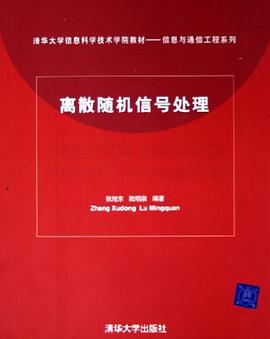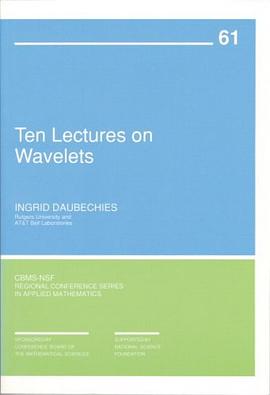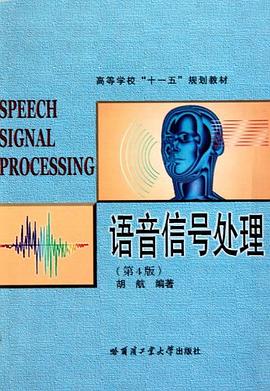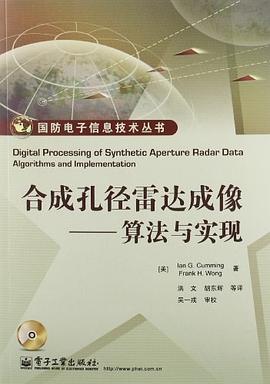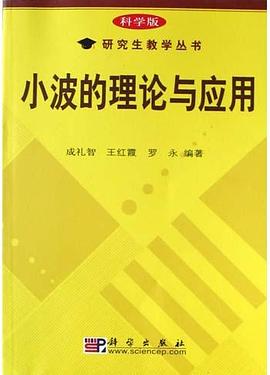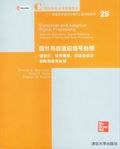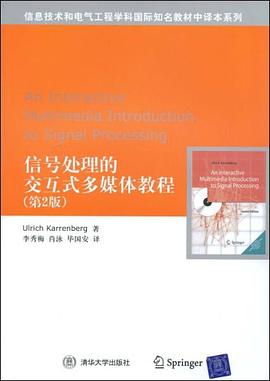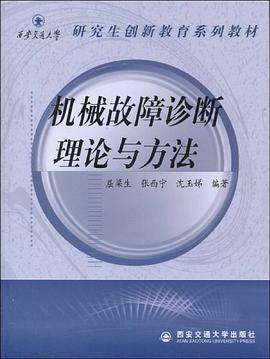

具體描述
《數字語音處理理論與應用(英文版)》是作者繼1978年版經典教材《語音信號數字處理》之後的又一著作,全書除有簡練精闢的基礎知識介紹外,係統介紹瞭近30年來語音信號處理的新理論、新方法和在應用上的新進展。全書共14章,分四部分:第一部分介紹語音信號處理基礎知識,主要包括數字信號處理基礎、語音産生機理、(人的)聽覺和聽感知機理和聲道中的聲傳播原理;第二部分介紹語音信號的時頻域錶示和分析;第三部分介紹語音參數估計算法;第四部分介紹語音信號處理的應用,主要包括語音編碼、語音和音頻信號的頻域編碼、語音閤成、語音識彆和自然語言理解。
著者簡介
圖書目錄
preface
chapter 1 introduction to digital speechprocessing
1.1 the speechsignal
1.2 the speechstack
1.3 applicationsof digital speechprocessing
1.4 commentonthe references
1.5 summary
chapter 2 reviewof fundamentalsof digitalsignalprocessing
2.1 introduction
2.2 discrete-time signals and systems
2.3 transform representation of signals and systems
2.4 fundamentalsof digitalfilters
2.5 sampling
2.6 summary
problems
chapter 3 fundamentalsof human speechproduction
3.1 introduction
3.2 the processofspeechproduction
3.3 short-timefourierrepresentationofspeech
.3.4 acousticphonetics
3.5 distinctivefeaturesof thephonemesof american english
3.6 summary
problems
chapter 4 hearing,auditory models,and speechperception
4.1 introduction
4.2 the speechchain
4.3 anatomy andfunctionof theear
4.4 the perception of sound
4.5 auditory models
4.6 human speechperceptionexperiments
4.7 measurementofspeechqualityand intelligibility
4.8 summary
problems
chapter 5 sound propagationinthe humanvocaltract
5.1 the acoustictheoryofspeechproduction
5.2 losslesstube models
5.3 digital models forsampled speechsignals
5.4 summary
problems
chapter 6 time-domainmethods for speechprocessing
6.1 introduction
6.2 short-timeanalysisofspeech
6.3 short-timeenergyand short-timemagnitude
6.4 short-timezero-crossing rate
6.5 the short-timeautocorrelation function
6.6 the modied short-timeautocorrelation function
6.7 the short-timeaverage magnitude differencefunction
6.8 summary
problems
chapter 7 frequency-domainrepresentations
7.1 introduction
7.2 discrete-timefourieranalysis
7.3 short-timefourieranalysis
7.4 spectrographicdisplays
7.5 overlapaddition methodof synthesis
7.6 filter bank summationmethodof synthesis
7.7 time-decimatedfilter banks
7.8 two-channelfilter banks
7.9 implementationof thefbs method usingthe fft
7.10 olarevisited
7.11 modicationsof thestft
7.12 summary
problems
chapter 8 thecepstrumand homomorphic speechprocessing
8.1 introduction
8.2 homomorphicsystems forconvolution
8.3 homomorphicanalysisofthe speechmodel
8.4 computingthe short-timecepstrumand complexcepstrum of speech
8.5 homomorphicfilteringofnatural speech
8.6 cepstrumanalysisofall-pole models
8.7 cepstrumdistancemeasures
8.8 summary
problems
chapter 9 linear predictive analysisof speechsignals
9.1 introduction
9.2 basic principles of linear predictive analysis
9.3 computationofthe gainfor themodel
9.4 frequencydomaininterpretationsof linear predictiveanalysis
9.5 solutionofthe lpcequations
9.6 the prediction errorsignal
9.7 somepropertiesofthe lpcpolynomial a(z)
9.8 relationoflinear predictive analysisto losslesstube models
9.9 alternative representationsof thelpparameters
9.10 summary 560problems
chapter 10 algorithms for estimating speechparameters
10.1 introduction
10.2 mediansmoothing and speechprocessing
10.3 speech-background/silencediscrimination
10.4 abayesianapproach tovoiced/unvoiced/silence detection
10.5 pitch period estimation(pitch detection)
10.6 formant estimation
10.7 summary 645problems
chapter 11 digitalcodingof speechsignals
11.1 introduction
11.2 sampling speechsignals
11.3 astatisticalmodelfor speech
11.4 instantaneous quantization
11.5 adaptivequantization
11.6 quantizingofspeechmodelparameters
11.7 generaltheoryof differentialquantization
11.8 delta modulation
11.9 differentialpcm (dpcm)
11.10 enhancements foradpcm coders
11.11 analysis-by-synthesis speechcoders
11.12 open-loop speechcoders
11.13 applicationsof speechcoders
11.14 summary 819problems
chapter 12 frequency-domaincodingof speechandaudio
12.1 introduction
12.2 historicalperspective
12.3 subband coding
12.4 adaptivetransform coding
12.5 aperception modelforaudiocoding
12.6 mpeg-1audiocoding standard
12.7 otheraudiocoding standards
12.8 summary 894problems
chapter 13 text-to-speechsynthesis methods
13.1 introduction
13.2 text analysis
13.3 evolutionof speechsynthesis methods
13.4 early speechsynthesis approaches
13.5 unitselection methods
13.6 tts future needs
13.7 visual tts
13.8summary 947problems
chapter 14 automatic speechrecognition andnatural language understanding
14.1 introduction
14.2 basic asrformulation
14.3 overall speechrecognition process
14.4 buildinga speechrecognition system
14.5 the decisionprocessesinasr
14.6 step3:the search problem
14.7 simpleasr system: isolateddigit recognition
14.8 performance evaluationof speechrecognizers
14.9 spokenlanguage understanding
14.10 dialog managementand spokenlanguage generation
14.11 user interfaces
14.12 multimodaluserinterfaces
14.13 summary 984problems
appendices
a speechandaudioprocessing demonstrations
b solutionoffrequency-domaindifferentialequations
bibliography
index
· · · · · · (收起)
chapter 1 introduction to digital speechprocessing
1.1 the speechsignal
1.2 the speechstack
1.3 applicationsof digital speechprocessing
1.4 commentonthe references
1.5 summary
chapter 2 reviewof fundamentalsof digitalsignalprocessing
2.1 introduction
2.2 discrete-time signals and systems
2.3 transform representation of signals and systems
2.4 fundamentalsof digitalfilters
2.5 sampling
2.6 summary
problems
chapter 3 fundamentalsof human speechproduction
3.1 introduction
3.2 the processofspeechproduction
3.3 short-timefourierrepresentationofspeech
.3.4 acousticphonetics
3.5 distinctivefeaturesof thephonemesof american english
3.6 summary
problems
chapter 4 hearing,auditory models,and speechperception
4.1 introduction
4.2 the speechchain
4.3 anatomy andfunctionof theear
4.4 the perception of sound
4.5 auditory models
4.6 human speechperceptionexperiments
4.7 measurementofspeechqualityand intelligibility
4.8 summary
problems
chapter 5 sound propagationinthe humanvocaltract
5.1 the acoustictheoryofspeechproduction
5.2 losslesstube models
5.3 digital models forsampled speechsignals
5.4 summary
problems
chapter 6 time-domainmethods for speechprocessing
6.1 introduction
6.2 short-timeanalysisofspeech
6.3 short-timeenergyand short-timemagnitude
6.4 short-timezero-crossing rate
6.5 the short-timeautocorrelation function
6.6 the modied short-timeautocorrelation function
6.7 the short-timeaverage magnitude differencefunction
6.8 summary
problems
chapter 7 frequency-domainrepresentations
7.1 introduction
7.2 discrete-timefourieranalysis
7.3 short-timefourieranalysis
7.4 spectrographicdisplays
7.5 overlapaddition methodof synthesis
7.6 filter bank summationmethodof synthesis
7.7 time-decimatedfilter banks
7.8 two-channelfilter banks
7.9 implementationof thefbs method usingthe fft
7.10 olarevisited
7.11 modicationsof thestft
7.12 summary
problems
chapter 8 thecepstrumand homomorphic speechprocessing
8.1 introduction
8.2 homomorphicsystems forconvolution
8.3 homomorphicanalysisofthe speechmodel
8.4 computingthe short-timecepstrumand complexcepstrum of speech
8.5 homomorphicfilteringofnatural speech
8.6 cepstrumanalysisofall-pole models
8.7 cepstrumdistancemeasures
8.8 summary
problems
chapter 9 linear predictive analysisof speechsignals
9.1 introduction
9.2 basic principles of linear predictive analysis
9.3 computationofthe gainfor themodel
9.4 frequencydomaininterpretationsof linear predictiveanalysis
9.5 solutionofthe lpcequations
9.6 the prediction errorsignal
9.7 somepropertiesofthe lpcpolynomial a(z)
9.8 relationoflinear predictive analysisto losslesstube models
9.9 alternative representationsof thelpparameters
9.10 summary 560problems
chapter 10 algorithms for estimating speechparameters
10.1 introduction
10.2 mediansmoothing and speechprocessing
10.3 speech-background/silencediscrimination
10.4 abayesianapproach tovoiced/unvoiced/silence detection
10.5 pitch period estimation(pitch detection)
10.6 formant estimation
10.7 summary 645problems
chapter 11 digitalcodingof speechsignals
11.1 introduction
11.2 sampling speechsignals
11.3 astatisticalmodelfor speech
11.4 instantaneous quantization
11.5 adaptivequantization
11.6 quantizingofspeechmodelparameters
11.7 generaltheoryof differentialquantization
11.8 delta modulation
11.9 differentialpcm (dpcm)
11.10 enhancements foradpcm coders
11.11 analysis-by-synthesis speechcoders
11.12 open-loop speechcoders
11.13 applicationsof speechcoders
11.14 summary 819problems
chapter 12 frequency-domaincodingof speechandaudio
12.1 introduction
12.2 historicalperspective
12.3 subband coding
12.4 adaptivetransform coding
12.5 aperception modelforaudiocoding
12.6 mpeg-1audiocoding standard
12.7 otheraudiocoding standards
12.8 summary 894problems
chapter 13 text-to-speechsynthesis methods
13.1 introduction
13.2 text analysis
13.3 evolutionof speechsynthesis methods
13.4 early speechsynthesis approaches
13.5 unitselection methods
13.6 tts future needs
13.7 visual tts
13.8summary 947problems
chapter 14 automatic speechrecognition andnatural language understanding
14.1 introduction
14.2 basic asrformulation
14.3 overall speechrecognition process
14.4 buildinga speechrecognition system
14.5 the decisionprocessesinasr
14.6 step3:the search problem
14.7 simpleasr system: isolateddigit recognition
14.8 performance evaluationof speechrecognizers
14.9 spokenlanguage understanding
14.10 dialog managementand spokenlanguage generation
14.11 user interfaces
14.12 multimodaluserinterfaces
14.13 summary 984problems
appendices
a speechandaudioprocessing demonstrations
b solutionoffrequency-domaindifferentialequations
bibliography
index
· · · · · · (收起)
讀後感
評分
評分
評分
評分
評分
用戶評價
评分
评分
评分
评分
评分
相關圖書
本站所有內容均為互聯網搜索引擎提供的公開搜索信息,本站不存儲任何數據與內容,任何內容與數據均與本站無關,如有需要請聯繫相關搜索引擎包括但不限於百度,google,bing,sogou 等
© 2025 book.quotespace.org All Rights Reserved. 小美書屋 版权所有

